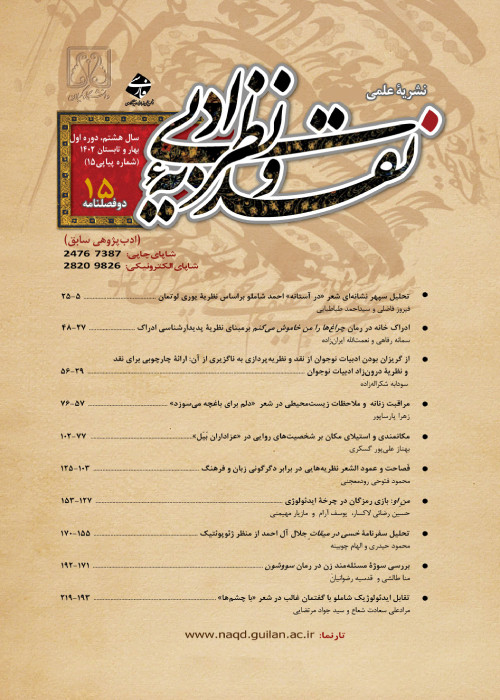A Study of the Ideas of the Commentators on Miftah al-Ulum regarding the Relationship between Ma’ani and Bayan
In a number of recent studies on the history of Islamic rhetoric the division of ma’ani (the study of syntax at the level of language) and bayan (the study of tropes and figures of speech) has been attributed to Abu Yaqub Al-Sakaki. On the other hand, some scholars believe that it was first Jorjani who subdivided the study of these sciences in the history of Islamic rhetoric. It is quite plain that this controversy among scholars is superficial because any shift in the study of sciences is gradual and its emergence is not spontaneous. The same is true of the division of ma’ani and bayan. Not only did it begin before Sakaki but it also took centuries after him for these sciences to become completely separated. Considering this fact in this paper, we have studied the means to which ma’ani and bayan became separated in the 7th and 8th centuries AD. Our study shows that Qotboddin Shirazi – one of the interpreters of Al-Meftah – is keen to emphasize the similarities of ma’ani and bayan. His views are later challenged by some other eminent interpreters in the 8th century AD. This shows how gradually this division occured in the history of Islamic rhetoric. This paper illustrates the confrontation between those who see ma’ani and bayan as almost similar fields and do not support their separation, and those who entirely support it.
As the development of concepts is a gradual process, historians are expected to study the formation of concepts as a constant process of change and evolution. In the present study two concepts of ma’ani (the study of syntax at the level of language) and bayan (the study of tropes and figures of speech), which were considered in the Islamic civilization to be the same for centuries, are examined. Some contemporary scholars believe that ma’ani and bayan were used interchangeably until the late 5th century A.H. According to Ahmad Matlub, Zamakhshari and Fakhr Razi treated ma’ani and bayan as a single concept and the first conceptual distinction between these two was made by Sakkaki in his Miftah al-Ulum in 626 A.H. Hashim Muhammad Hashim Mahmoud similarly holds that before Sakkaki rhetoric was not divided into ma’ani and bayan.
Theoretical Framework
The present article is based on the idea that concepts go through changes in their meaning and application throughout their history, making it impossible to understand a concept without knowing about the changes it has undergone. Thus, here, attempt is made to examine the process through which ma’ani and bayan developed separate meanings.
As in the present article Sakkaki is considered to be the first person to distinguish between ma’ani and bayan, this study will focus on a period covering one century before and one century after him, i.e. 6th to 8th century A.H. Annotations on Miftah al-Ulum, which have attracted little attention, will be the focus of attention.
Based on the results of the present study, the distinction between ma’ani and bayan can be traced back to Sakkaki rather than Abd al-Qahir al-Jurjani. Before Sakkaki, Fakhr al-Din al-Razi had practically, rather than theoretically, distinguished between these two terms when outlining the main topic of his book Nihayah al-Ijaz fi Dirayah al-‘I’jaz. Motarzi Ganjavi has written an important introduction to rhetoric, in which he has somehow divided rhetoric into ma’ani, bayan and badi’. However, it was not until about one hundred years after Sakkaki that the separation between ma’ani and bayan was accepted by most scholars. In the decades following Sakkaki, commentators on his work were divided into two groups: one agreeing with a minimal separation of these two sciences and the other accepting a maximal distinction. However, with the emergence of scholars such as Taftazani and al-Jurjani the ground was prepared for accepting the separation of these sciences.
A close study of commentaries on Miftah al-Ulum reveals that the farther we get from the time of Sakkaki, the larger grows the number of supporters of separation of these two sciences. Sakkaki’s position in this regard is somewhat ambiguous; he considers bayan to be a branch of man’ani, but at the same time he devoted two separate chapters to them, with distinct definitions for each science. Some scholars, however, believe that al-Jurjani laid the foundation for the separation of these two sciences by writing a book about each. If we accept this to be the case, then, al-Jurjani’s works should be examined to arrive at an answer to the questions concerning the separation of these sciences.
- حق عضویت دریافتی صرف حمایت از نشریات عضو و نگهداری، تکمیل و توسعه مگیران میشود.
- پرداخت حق اشتراک و دانلود مقالات اجازه بازنشر آن در سایر رسانههای چاپی و دیجیتال را به کاربر نمیدهد.



